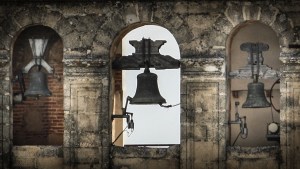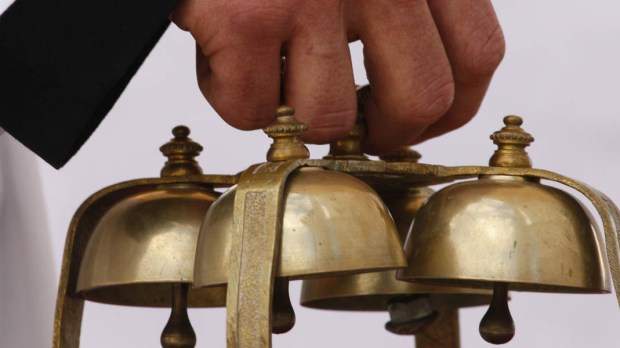Depending on the church you attend, you may hear the sound of bells ringing at pivotal points in the Mass. While it is no longer a universal practice in the Catholic Church, it points to an ancient historical practice that awakens our senses during the liturgy.
In describing the vestments worn by the priests of Israel like Aaron, God explains to Moses how bells should be sewn on them.
On its skirts you shall make pomegranates of blue and purple and scarlet stuff, around its skirts, with bells of gold between them, a golden bell and a pomegranate, a golden bell and a pomegranate, round about on the skirts of the robe. And it shall be upon Aaron when he ministers, and its sound shall be heard when he goes into the holy place before the Lord, and when he comes out, lest he die.
Exodus 28:33-35
Bells were an integral part of divine worship, both to sound a joyful noise before the Lord and to ward off evil spirits. This particular feature of bells is still preserved in the Roman Ritual blessing of bells where the priest prays, “At its sound let all evil spirits be driven afar.”
As Christianity grew, bells were slowly added to the liturgy in various ways. At first bells were mounted in towers outside of churches to call people to worship, but soon enough handheld bells were used for similar purposes. For example, it is believed St. Patrick used such a handbell and “whenever Saint Patrick had set up a new Christian community or parish somewhere in Ireland, he would choose one of his disciples to lead it after he left, and present them with a bell to call the parishoners to prayer, and to use during religious ceremonies.”
More in line with the Old Testament, small bells were adapted in Eastern Churches in various ways, such as bells that were attached to the thurible that carried incense used at divine worship.
In the Roman Rite handbells were eventually used by altar servers to mark important moments during the Mass. It currently remains an option, as it is noted in the General Instruction of the Roman Missal, “A little before the Consecration, if appropriate, a minister rings a small bell as a signal to the faithful. The minister also rings the small bell at each elevation by the Priest, according to local custom” (No. 150).
The bells have great spiritual power and alert our senses to what is unfolding before us. They not only provoke our attention, but are also a “joyous noise” at the pivotal moments in the Mass when God comes down from Heaven and takes the appearance of bread and wine.
It is not meant to be a distraction, but another way to praise God and focus our wandering attention. Or as the Psalmist sings, “Praise him with sounding cymbals; praise him with loud clashing cymbals! Let everything that breathes praise the Lord! Praise the Lord!” (Psalm 150:5-6)

Read more:
The surprising spiritual power of church bells

